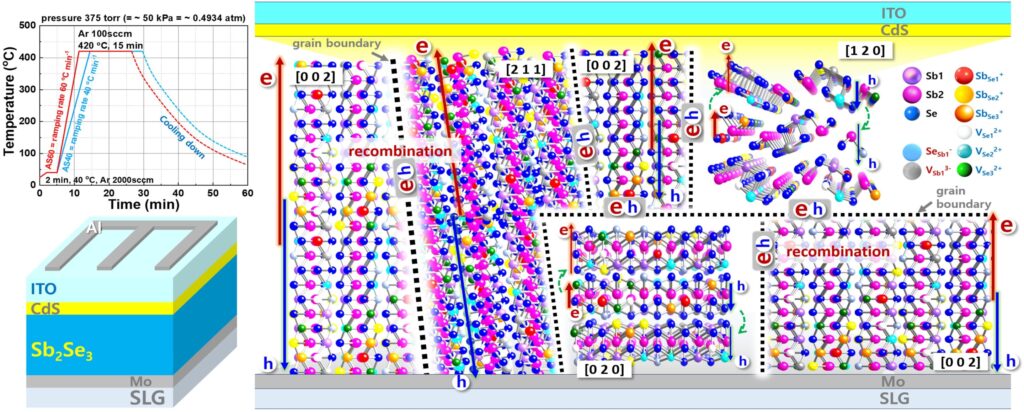A research team has discovered a technology that significantly enhances the efficiency of eco-friendly solar cells through simple temperature control. They found that rapidly increasing the temperature during material thermal processing leads to more orderly crystal growth and smoother charge transport. The study is published in the Journal of Materials Chemistry A.
Antimony selenide (Sb₂Se₃) is an eco-friendly next-generation solar cell material composed solely of antimony (Sb) and selenium (Se), both of which are abundant on Earth, and it contains no harmful elements, such as cadmium (Cd) and lead (Pb). It has attracted significant attention as a robust yet eco-friendly energy material capable of low-cost, large-scale production, thanks to its strong light absorption and excellent thermal and chemical stability.
However, conventional Sb₂Se₃-based devices suffer from reduced efficiency because random crystal orientation and structural defects hinder electron and hole transport.
The research team found a clue to addressing this problem in the crystal growth rate, specifically, in the heating rate during the solar cell fabrication process. They discovered that a higher heating rate facilitates uniform crystal alignment and reduces defects, enabling smooth charge transport and a substantial improvement in efficiency. This finding revealed that even simple temperature control can alter crystal structure and charge-transport properties, thereby fundamentally improving device performance.
The research team conducted a detailed investigation of defect characteristics using various analytical techniques, including scanning electron microscopy (SEM), X-ray diffraction (XRD), ultraviolet photoelectron spectroscopy (UPS), admittance spectroscopy, and STEM-EDS. The results showed that a gradual increase in temperature caused the crystals to grow in random orientations, resulting in more defects and hindered charge transport.
In contrast, a faster heating process produced uniformly aligned crystals, leading to smoother electron flow and enhanced efficiency. These results experimentally demonstrate that an increased crystal growth rate can reduce defects and facilitate electron transport.
The researchers were led by Principal Researchers Dae-Hwan Kim and Kee-Jeong Yang from the Division of Energy & Environmental Technology at DGIST, in collaboration with Professor Junho Kim’s team at Incheon National University.
Yang stated, “This study provides a clue to addressing one of the key limitations of antimony selenide solar cells, namely, the issues of crystal orientation and structural defects. By simply controlling the crystal growth rate at the early stage of the fabrication process, we can maximize the material’s potential. This is expected to greatly contribute to future commercialization and the development of large-area modules.”
More information:
Jaebaek Lee et al, Effect of crystal growth rate on crystal direction, defect formation, and photovoltaic performance of Sb2Se3 thin-film solar cells, Journal of Materials Chemistry A (2025). DOI: 10.1039/d5ta05256d
Provided by
Daegu Gyeongbuk Institute of Science and Technology (DGIST)
Citation:
Enhancing eco-friendly solar cells through simple temperature control (2025, October 27)
retrieved 28 October 2025
from https://techxplore.com/news/2025-10-eco-friendly-solar-cells-simple.html
This document is subject to copyright. Apart from any fair dealing for the purpose of private study or research, no
part may be reproduced without the written permission. The content is provided for information purposes only.

